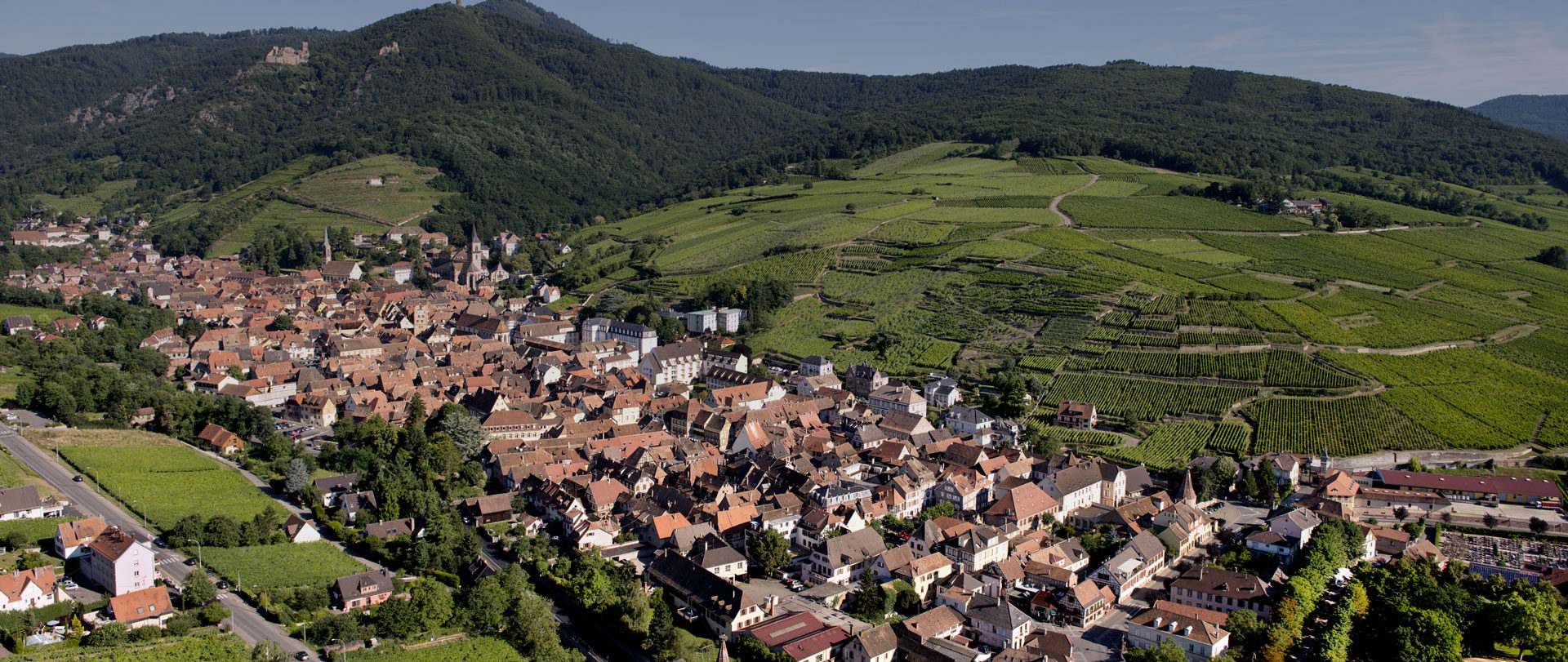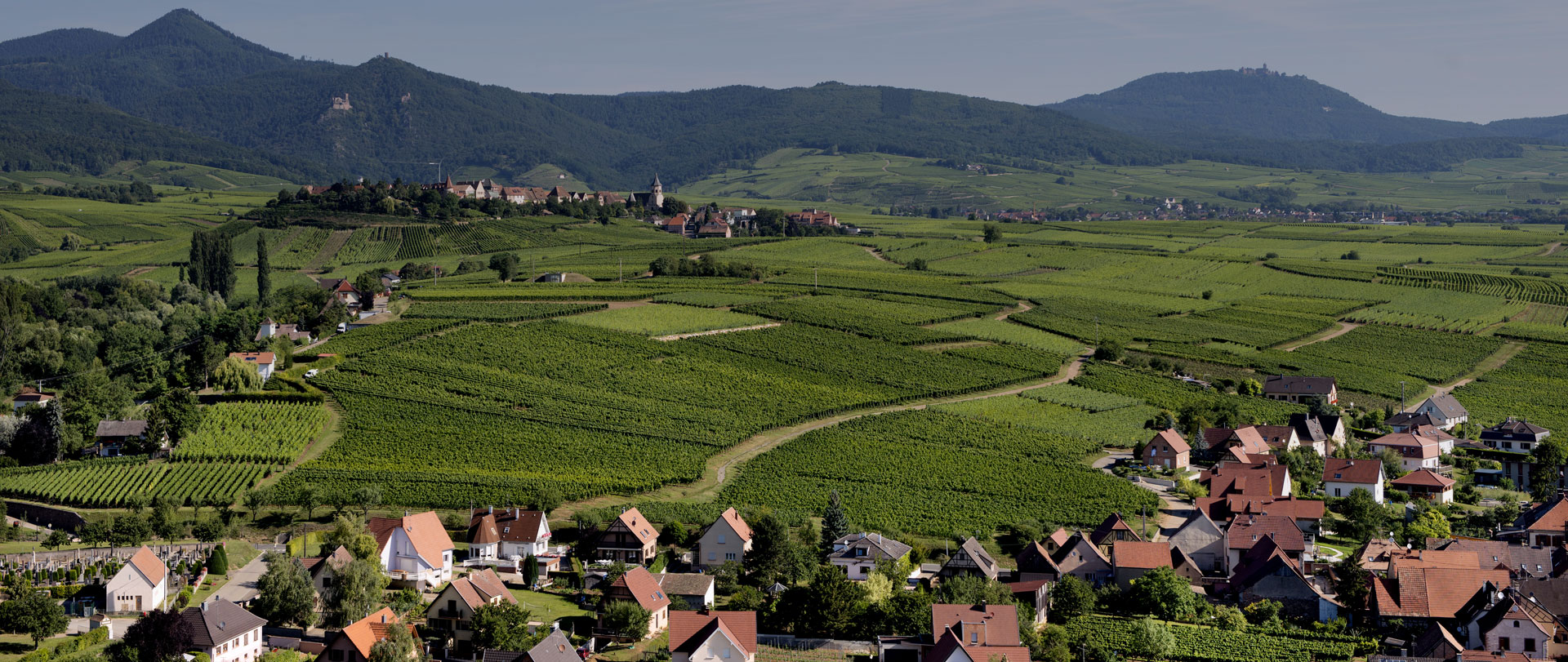The terroir
The Grand Cru Osterberg is a terroir which ensures that the grape varieties grow in a balanced way, nourished by the resources of a site which draws its greatest luminosity from the sky and its mineral mosaic from the earth.
This terroir is part of the Ribeauvillé fracture zone. Facing predominantly east, and particularly sunny, it enjoys a remarkable location that takes full advantage of its slopes of varying gradient (10 to 30%). Bordered to the west by Ribeauvillé’s Grands Crus Geisberg and Kirchberg, it completes the trilogy of Ribeauvillé Grands Crus.
As Serge Dubs and Denis Ritzenthaler point out, “The marl-limestone-sandstone soil of this terroir (…) is a well-balanced cocktail capable of producing great wines (…) All four authorised grape varieties succeed here. This complicates the choice of producers who have to determine objectively which one is best able to give the quintessence of the marriage between the terroir and the grape variety’. (Dubs, Les Grands Crus d’Alsace, p. 159).
This source of richness is attested to by the presence in this Grand Cru of the Clos du Zahnacker, where complantation has been proven for nine centuries.
This demanding terroir requires the winegrowers to limit production by various methods. There are still many old vines with low yields. Pruning is rigorous and helps to control production potential.
History
The Osterberg site has belonged to the Grands Crus since 1992, but it is already mentioned in documents dating back to the Middle Ages, and the lords of Ribeaupierre had their vines there. On the subject of Ribeauvillé, Michel Mastrojanni explains:
« An imperial town and former stronghold of the powerful Ribeaupierre family, which dominated the region from the 13th century until the French Revolution (acquiring numerous vineyards in the region from Ammerschwihr to Rodern), the town of the Ménétriers received many privileges and enjoyed constant prosperity in the wine industry. »
The wines
The acidity induced by this terroir is expressive with all the grape varieties. The acidity of the Riesling gives the wine an extra boost, while the Pinot Gris and Gewurztraminer find a subtle and rare balance in this Grand Cru. The expression of yellow and white fruit is both complex and delightful.
This Grand Cru stands out for its strength
« Its great body, derived from the marl of the terroir, gives a full, even heady volume to the dry wines. The freshness here is a little austere when young, but it gives the wines a robust structure. This freshness will later show itself to be a factor of volume, and will then delight the taster. Exotic aromas of mango, passion fruit and honey are often present. They form a rich prelude to these long, charming wines.
The width and acidity induced by this terroir are expressive with all the grape varieties.
While the natural acidity of the Riesling gives the wine extra tone and expresses notes of dried herbs, the Pinot Gris and Gewurztraminer find a subtle and rare balance with this Grand Cru, balancing between sweetness and freshness. The expression of yellow and white fruit is both complex and delightful. »
Vintages
The great Osterberg vintages: 1971, 1975, 1976, 1983, 1985, 1988, 1989, 1990, 1995, 1996, 1998, 1999, 2000, 2001, 2002, 2004, 2005, 2007, 2008, 2009, 2010, 2011.
«When young, Osterberg gives a lot of pleasure. But waiting five or six years will allow it to really reveal its potential. This period of latency will refine its structure and, above all, allow the intense minerality to explode, making this cru a terroir in a class of its own, capable of admirable ageing.
In early vintages, the wines are charming and exotic, and generally mature fairly quickly. Their acidity is subtly coated, giving a honeyed sensation. The wines are long, broad and generous, often marked by notes of dried herbs.
In late vintages, the slightly denser texture is still reminiscent of honey. The wine’s flesh is a little airier, allowing notes of white fruit to come through. The long finish is intensely mineral, evocative of warm stones. »
Pairings
They even stand out with dishes of great aromatic power.
“Fish and seafood served with spicy sauces are the perfect accompaniment. The firm structure of Osterberg wines makes them ideal with white meats – veal or poultry accompanied by mushrooms, for example.”
Photo © ZVARDON / Textes CIVA – www.VinsAlsace.com





